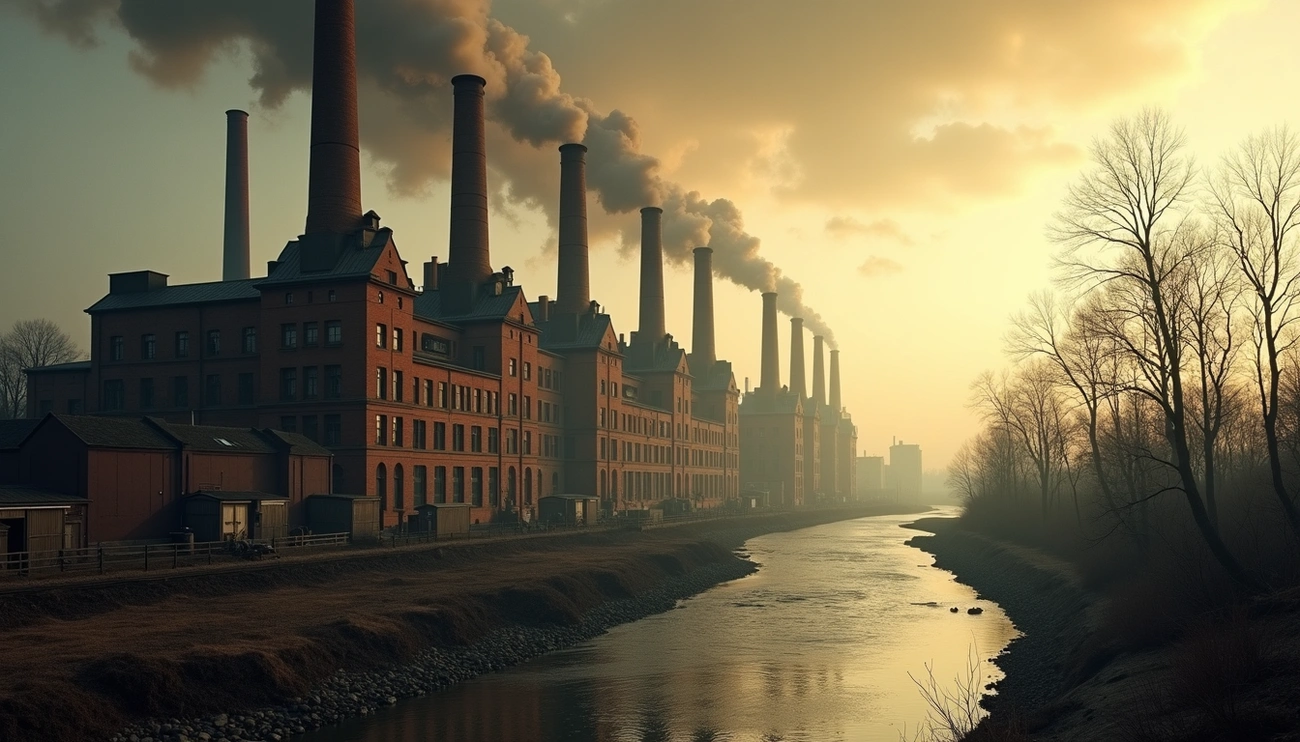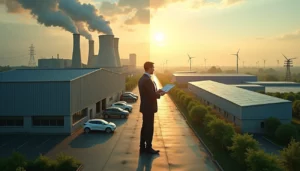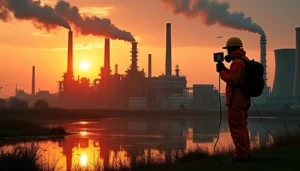The Industrial Revolution transformed how humans interacted with and affected Earth’s environment in less than 100 years between the eighteenth and nineteenth centuries. Britain’s industrial changes spread to other nations and completely altered their economies. These changes have unleashed unprecedented environmental consequences that continue to appeal to people today. Our planet’s ecological systems changed forever in ways that previous generations could never have imagined.
The Industrial Revolution brought immediate and widespread environmental damage. Factories multiplied across landscapes while air and water pollution came from coal burning and the production of metals and simple chemicals. Industrial activities sped up natural resource exploitation at unprecedented rates. Global population numbers reached 1 billion by 1800 and doubled again by 1926. Production and population growth created environmental pressures never seen before in human history.
People left the countryside for machinery-filled factories in rapidly growing cities as the Industrial Revolution pushed relentlessly forward. The economic transformation extracted a heavy environmental toll. Factories grew larger, and their endless need for raw materials caused widespread pollution. Coal burning pumped chemicals and particulates into the atmosphere. Manufacturing processes filled waterways with industrial waste, disrupting ecosystems that had remained stable for centuries.
Environmental damage became permanent rather than temporary as humanity’s relationship with nature changed forever. Industrialized nations’ economic and military strength stemmed from their industrial base, which triggered ecological changes that extended far beyond the Industrial Revolution itself. Modern societies face challenges from climate instability to resource depletion. This period’s environmental legacy continues to reshape our world and will affect generations to come.
Resource Extraction and the Rise of Industrial Materials
The intensive extraction of natural resources laid the foundations of the Industrial Revolution, altering Earth’s landscapes and ecosystems forever. Coal, iron, and steel accelerated industrial growth and triggered unprecedented environmental changes through their extraction and processing.
Coal Mining and Iron Smelting in 18th-Century Britain
Britain switched to coal as its primary fuel source in the late 18th century. This change replaced wood as a source for heating homes and powering factories. Coal production jumped from 5.2 million tons in 1750 to 62.5 million tons by 1850. This massive increase brought severe environmental damage. Deep mining operations degraded landscapes, polluted water, and released toxic materials into the environment. Miners risked their lives daily, facing tunnel collapses, poisonous gases, and diseases like “black lung” from breathing coal dust. The 1812 Felling Colliery disaster claimed 92 miners’ lives when fire-damp gas exploded. Iron smelting made significant progress after Abraham Darby used coke (processed coal) instead of charcoal around 1709. This innovation helped Britain’s iron production expand from 12,000 tons in 1700 to 400,000 tons by 1820.
Steel Production and the Expansion of Railways
Henry Bessemer’s 1856 invention of the Bessemer converter transformed steelmaking completely. His process removed impurities from pig iron with high-pressure air and cut steel production costs from £50 per ton to just £4 by 1875. Steel production paved the way for massive railway expansion. America’s transcontinental railroad, completed in 1869, required 21,000 workers to lay 1,776 miles of track, at a cost of approximately $60 million ($1.2 billion today). Sheffield became steel production’s world center and exported over 280,000 kilometers of rails to the USA alone between 1865-1874. Notwithstanding that, steel production grew into the most energy-consuming and CO2-emitting industrial activity worldwide, using about 20 gigajoules of energy per ton produced.
Colonial Resource Exploitation and Environmental Cost
Industrial powers systematically stripped colonial territories of raw materials. They extracted natural resources from colonized regions, disregarding the environmental and human damage. Mining operations expanded through forced labor and degraded landscapes while depleting resources at unsustainable rates. Extractive industries now generate half of the world’s carbon emissions and cause more than 80% of biodiversity loss. The global North drains resources worth $2.2 trillion annually from the South. This colonial exploitation created patterns of environmental destruction that continue today. Mining activities contaminate soil, cause heavy metal pollution, and inflict long-term ecosystem damage.
Fossil Fuels and the Birth of Industrial Pollution
The rise of fossil fuel use and fossil fuel consumption changed Earth’s atmosphere in fundamental ways. This introduced industrial pollution at levels never seen before. Coal became the primary energy source powering manufacturing, but it left lasting damage to our environment.
Coal Combustion and Sulfur Dioxide Emissions
Early industrial coal burning released vast amounts of sulfur dioxide (SO₂) into the air. This created major air quality problems in cities. The late eighteenth century saw a surge in SO₂, nitrogen dioxide, ammonia, and smoke emissions as cities burned more coal. People nicknamed London and Edinburgh “the Smoke” and “Auld Reekie” because of their poor air quality. Major cities recorded SO₂ and smoke levels between 50-100 μg/m³ by the mid-twentieth century. Bad weather exacerbated these levels, sometimes reaching over 1,000 μg/m³. The notorious 1952 London smog killed about 12,000 people prematurely.
Greenhouse Gas Emissions from Early Factories
Early factories created greenhouse gas emission patterns we still see today. Before 1750, CO₂ levels in the atmosphere stayed around 275 parts per million (ppm). Today’s levels have reached 415 ppm, which means CO₂ concentrations have jumped by more than 40%. We have released about 2.3 trillion tons of CO₂ since industrialization began. Oceans and ecosystems have absorbed only half of this amount. Coal stands out as the most significant cause of global climate change, contributing about 46% of all human-made greenhouse gases since 1750.
Dependence on Non-renewable Energy Sources
The Industrial Revolution created a reliance on fossil fuels that has dominated our energy needs for centuries. Coal powered factories, transportation, and heating first. Later, this expanded to include oil and natural gas. Human activities now release more than 30 billion tons of CO₂ each year. This dependence on non-renewable resources has sped up environmental damage. Europe and North America produced over 80% of global SO₂ emissions before 1970. Today, developing nations face these same pollution challenges.
Urbanization, Population Growth, and Environmental Stress
The mass movement of people from the countryside to cities changed how humans lived during the Industrial Revolution. This radical alteration led to several environmental problems that nobody expected.
Mass Migration to Cities and Sanitation Collapse
Cities grew rapidly as people looked for factory jobs. The US population grew from 5.3 million to 76.2 million between 1800 and 1900. London’s population jumped from 60,000 in 1800 to 142,000 by 1842. Cities were unable to handle this explosive growth due to their simple infrastructure. Manchester’s situation in 1847 shows how bad things were. Out of 47,000 houses, only 11,000 had piped water. Another 12,000 used shared street taps, while thousands relied on contaminated shallow wells. The waste management systems failed miserably. Sewers were nothing more than long cesspools until the 1840s. Up to 30 families shared toilet pits called privy middens. These pits were rarely emptied, allowing human waste to leak into waterways.
Overcrowding and the Spread of Waterborne Diseases
Poor sanitation and packed living spaces created the perfect storm for diseases to spread. Cholera hit industrial cities hard. London lost about 15,000 people to this disease between 1848 and 1849. Yes, it was so bad that Manchester’s laborers lived only 17 years on average. Water pollution reached extreme levels. The River Irwell’s riverbed rose about three inches every year by the 1860s due to pollution. Other industrial cities faced similar problems as sewage poisoned their drinking water.
Deforestation for Urban Expansion and Agriculture
Growing cities needed more land. The US population tripled between 1850 and 1900, and forests disappeared to make room for new settlements. Railways alone used 20-25% of US timber by the late 1800s. Railroad ties needed 15 million acres of cleared forests in 1900. America’s wooden fences stretched about 3.2 million miles by 1850—enough to circle Earth 120 times. Farming also accelerated deforestation as agriculture transitioned from local systems to a global market.
Loss of Biodiversity in Industrial Zones
Industrial growth destroyed ecosystems through habitat loss and pollution. New settlements directly harmed wildlife’s homes. Farmers started growing the same crops everywhere, which killed off local species and their helper organisms. This wiped out countless nitrogen-fixing bacteria, fungi, pollinators, and other related species. The first endangered species list in 1967 showed more than 70 threatened species. As industrial farming spread worldwide, it created similar pressures everywhere, further reducing ecological diversity.
Industrial Legacy: Accidents, Climate Change, and Global Impact
The price of technological progress without proper safety measures has been devastating. Industrial accidents have created environmental catastrophes that continue to impact our world today.
Chernobyl and the Rise of Industrial Disasters
The Chernobyl nuclear disaster of 1986 remains one of humanity’s worst industrial catastrophes. The explosion of reactor number four released 5% of radioactive material into the environment—this contaminated 150,000 square kilometers of land across Belarus, Russia, and Ukraine. The human toll was immediate – 30 operators and firefighters lost their lives to Acute Radiation Syndrome within three months. The disaster forced 350,000 people to leave their homes. Official records show about 5,000 thyroid cancer cases with 15 deaths, but unofficial estimates point to 90,000 deaths. The catastrophe pushed 110 countries to sign the Convention on Early Notification of a Nuclear Accident.
Bhopal Gas Tragedy and Toxic Exposure
The Bhopal disaster struck on December 3, 1984. A deadly leak of 45 tons of methyl isocyanate gas escaped from Union Carbide’s pesticide plant in India. The toxic cloud exposed 500,000 people to fatal chemicals. More than 10,000 people died in just three days. The death toll climbed to 22,000 as years passed. The tragedy continues today. Thousands of tons of toxic waste lie buried around the abandoned plant. This poisons the drinking water of 200,000 people across 71 villages. Dow Chemical bought Union Carbide in 2001, but both the company and the U.S. government avoided taking responsibility.
Long-term Climate Effects of Industrial Emissions
The Industrial Revolution changed Earth’s atmosphere forever. Carbon dioxide levels rose more than 40% from their original 280 parts per million to 419 ppm in 2023. Methane now exists at 2.5 times its original levels. Human activities released 2.3 trillion tons of CO₂ during the industrial era. Oceans and ecosystems absorbed only half of these emissions. Coal use alone makes up 46% of all human-made greenhouse gases since 1750.
The Industrial Revolution’s Role in the Modern Climate Crisis
Our dependence on fossil fuels, which began with the Industrial Revolution, continues to shape our world today. Humans now release 35 billion tons of carbon dioxide each year. Rich and upper-middle-income countries create most emissions. The world’s poorest nations contribute less than 1%—former colonial powers in the Global North account for 79% of historical carbon emissions. Scientists are 95% certain that human activities since industrialization have caused most of the observed warming.
Conclusion
The Industrial Revolution changed our planet’s environmental systems forever. People started extracting coal, iron, and steel on a massive scale. This activity transformed landscapes worldwide and created patterns of ecological damage that we still see today. The widespread use of fossil fuels led to unprecedented pollution. These changes have permanently altered our atmosphere through greenhouse gas emissions, resulting in carbon dioxide levels increasing by more than 40% compared to pre-industrial times.
People moved to cities in huge numbers during this period. Urban centers were unable to handle the strain on their sanitation systems, resulting in health crises. Farmers cleared more land for agriculture, leading to the disappearance of forests. Natural habitats vanished, and many species died out. As industrial practices spread around the world, their environmental toll became clear. Some regions suffered much more than others.
Of course, the Industrial Revolution’s environmental damage didn’t stop with the era itself. Disasters like Chernobyl and Bhopal showed us how dangerous technology can be without proper safety measures. Climate change has become our most significant environmental challenge today, primarily due to industrial emissions. Developed nations and former colonial powers created most of these historical emissions. Yet people in developing regions often face the worst effects.
The Industrial Revolution’s influence continues to shape our relationship with the environment. Modern technology has helped us reduce some types of pollution and work more efficiently. However, industrial activity still harms the environment in many ways. We must now address these deep-rooted environmental problems while maintaining economic stability. This complex connection between industry and environmental change remains crucial as we tackle ecological challenges in the twenty-first century.
FAQs
Q1. What were the major environmental impacts of the Industrial Revolution? The Industrial Revolution led to widespread air and water pollution from coal burning and industrial waste, extensive deforestation for urban expansion and agriculture, and a dramatic increase in greenhouse gas emissions. It also caused resource depletion, habitat destruction, and loss of biodiversity in industrial zones.
Q2. How did the Industrial Revolution affect urban environments? The Industrial Revolution triggered massive urban migration, leading to overcrowding and a collapse in city sanitation. This resulted in the spread of waterborne diseases, contamination of water sources, and a significant decrease in life expectancy for urban laborers. Cities struggled to manage waste and provide clean water to rapidly growing populations.
Q3. What long-term climate effects resulted from Industrial Revolution emissions? Industrial Revolution emissions have permanently altered Earth’s atmospheric composition. Carbon dioxide levels have increased by over 40% since pre-industrial times, while methane levels have risen 2.5 times. These changes have been the dominant cause of observed global warming, with human activities releasing about 35 billion tons of carbon dioxide annually.
Q4. How did resource extraction during the Industrial Revolution impact the environment? Resource extraction during the Industrial Revolution led to extensive landscape degradation, water pollution, and the release of toxic materials into the environment. Coal mining and iron smelting caused significant environmental damage, while colonial resource exploitation resulted in unsustainable rates of resource depletion and long-term ecosystem damage in colonized regions.
Q5. What are some examples of industrial disasters that highlight the environmental risks of industrialization? The Chernobyl nuclear disaster in 1986 and the Bhopal gas tragedy in 1984 are prime examples of industrial disasters with severe environmental consequences. Chernobyl contaminated vast areas with radioactive material, while the Bhopal incident exposed hundreds of thousands to toxic chemicals, resulting in long-term health and environmental impacts in the affected regions.
Our carbon experts help production studios frame strategy, train teams and track results — tailored to operational constraints.





